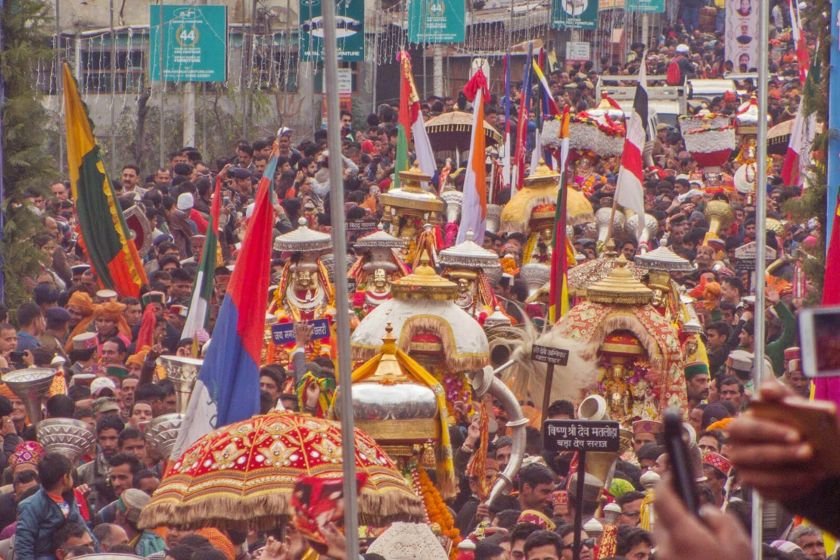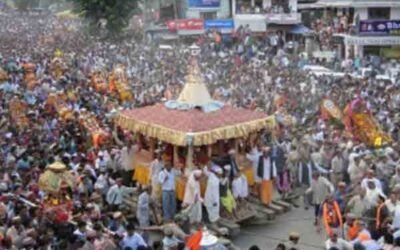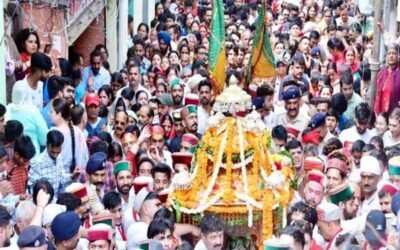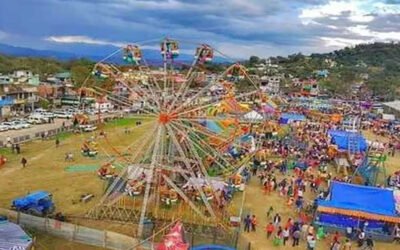📍 Location: Mandi Town, Himachal Pradesh
📅 Season: February–March (on Shivratri, varies by lunar calendar)
A divine assembly where over 200 hill deities descend to celebrate the cosmic lord beneath Mandi’s temple-studded skyline
🔱 The Living Land of Shiva
Mandi isn’t just a town—it’s a spiritual tapestry with over 80 temples dedicated to various forms of Lord Shiva. Known locally as Chhoti Kashi, it becomes the focal point of divine congregation during Shivratri, when the region’s presiding deity—Lord Madho Rai (Vishnu’s avatar)—invites fellow deities to honor Lord Shiva.
📜 A unique tradition here is that Lord Vishnu (Madho Rai) is considered Mandi’s ruler, and Lord Shiva is its guest—creating a Vaishnav-Shaiva harmony celebrated through ritual and procession.
🐘 Devta Durbar – The Gathering of Gods
The festival begins with a magnificent procession, where over 200 hill deities from Mandi and surrounding valleys arrive in ornate palanquins accompanied by drums, conches, and chanting.
- Procession to Madho Rai Temple: Deities are welcomed by the reigning idol of Lord Vishnu
- Temple Offerings: Rituals performed at Bhootnath Temple, one of Mandi’s oldest Shiva shrines
- Flag Ceremony: A sacred banner is hoisted to mark the start of festivities
The Devta Durbar is not symbolic—it’s living tradition, with divine energies believed to inhabit each palanquin.
🎭 Culture Along the River Beas
Held on the banks of the Beas River, the fair unfolds into a cultural celebration:
- Nati, Karyala, and Bhajans: Folk dances and spiritual songs light up the evenings
- Craft Stalls: Himachali woollens, wooden carvings, silver jewelry, and religious art on display
- Pahari Cuisine Stalls: Local food like chha gosht, madra, siddu, and meethe chawal served by vendors and families
Artists, saints, and locals converge—culture, commerce, and spirituality blend seamlessly.
🔔 Rituals of Reverence and Renewal
Across the week, daily rituals are performed in temples and tents:
- Shiv Abhishekam at Bhootnath and Trilokinath Temples
- Nightlong Jagrans by bhajan mandalis
- Devta Dialogues: Mediums (gur) of deities deliver guidance and blessings to devotees
- Traditional Fire Ceremonies: Held near the ghats for community purification
Devotees walk through temple lanes lit with lamps and incense—a sensory immersion into Himachali belief.
✨ Why Mandi Shivratri Resonates Deeply
This isn’t just a fair—it’s a spiritual parliament, a convergence of centuries-old faith and folk vibrance. It reflects:
- The respect for local devtas as divine custodians of landscape and life
- Shiva as the cosmic anchor for mountain culture
- Mandi’s unique blend of Vaishnav and Shaiva traditions—bridging gods and generations
🌌 It’s Himachal’s divine dialogue—where gods don’t just reign from temples, but walk among the people.
🧭 Plan Your Divine Visit
To experience Mandi Shivratri in full spirit:
- Best Time: February–March; dates follow lunar calendar Shivratri
- Where to Stay: Guesthouses in Mandi town, homestays near Rewalsar, or riverside eco-lodges
- Travel Tip: Reach a day early to witness the Devta Durbar’s ceremonial arrival
- Cultural Tip: Dress modestly, bring offerings (coconuts, sweets), and follow temple etiquette during jagrans and aartis




